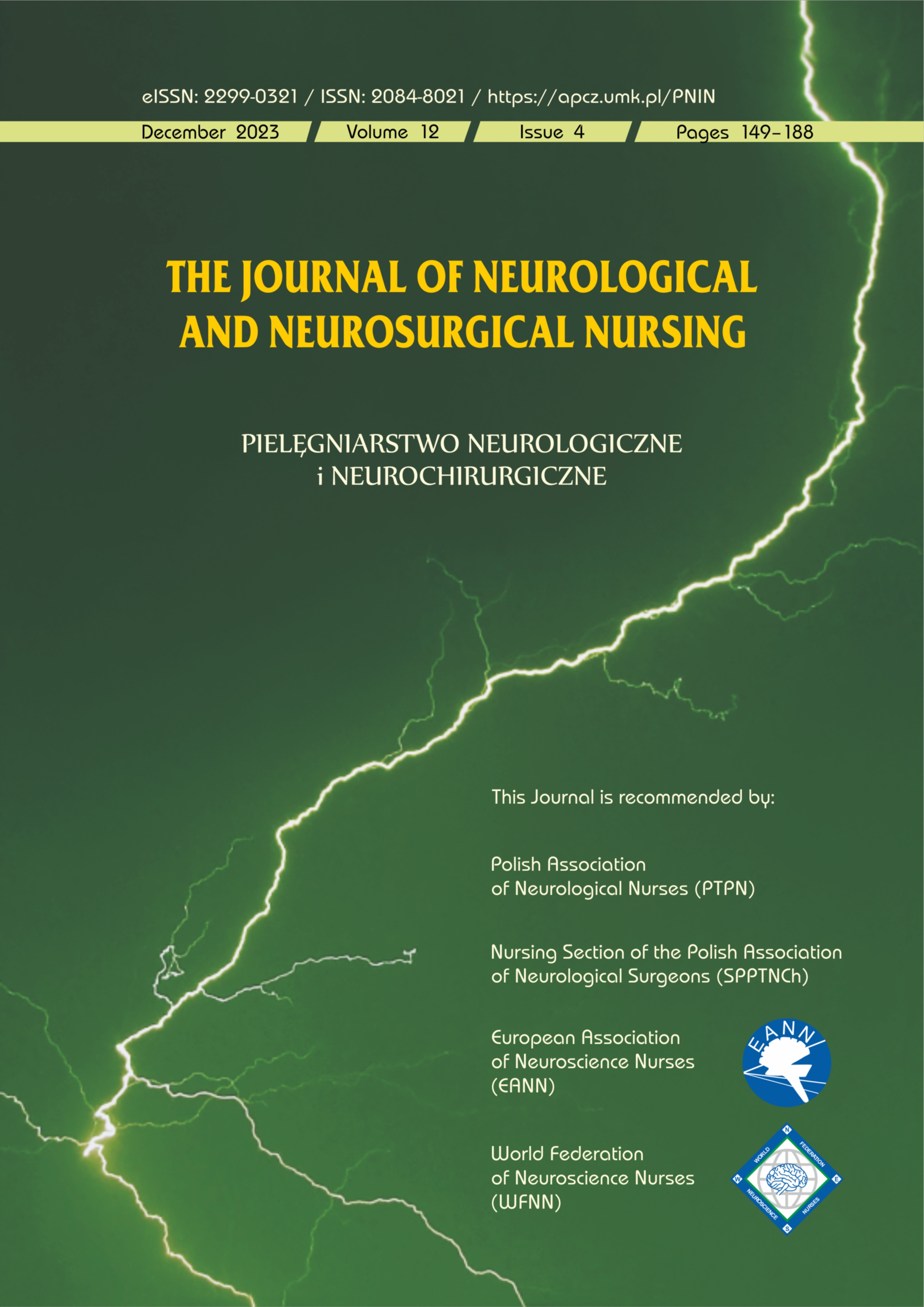Charakterystyka problemów pacjenta z guzem przysadki mózgowej leczonym endoskopowo przez zatokę klinową
DOI:
https://doi.org/10.15225/PNN.2023.12.4.4Słowa kluczowe
zabieg endoskopowy, problemy pielęgniarskie, przysadka mózgowaAbstrakt
Wstęp. Guzy przysadki to zazwyczaj łagodne gruczolaki. Leczenie operacyjne najczęściej dedykowane jest pacjentom z gruczolakami, które powodują objawy z ucisku takie jak zaburzenia widzenia, bóle głowy czy objawy wynikające z zaburzeń hormonalnych.
Cel. Celem pracy jest przedstawienie charakterystycznych problemów pacjenta z makrogruczolakiem przysadki mózgowej poddanego operacji endoskopowej przez zatokę klinową.
Opis przypadku. Zaprezentowano studium indywidualnego przypadku 42-letniego mężczyzny z makrogruczolakiem przysadki, poddanego leczeniu operacyjnemu przez zatokę klinową. Problemem występującym przed leczeniem neurochirurgicznym chorego były bóle głowy, zaburzające jego funkcjonowanie. Okres pooperacyjny przebiegał bez powikłań, ale wymagał uważnego monitorowania pacjenta pod kątem wycieku płynu mózgowo-rdzeniowego z nosa, moczówki prostej oraz zaburzeń elektrolitowych.
Dyskusja. Analizowany przez nas przypadek wymagał wzmożonej wielokierunkowej obserwacji ze względu na ryzyko wystąpienia powikłań. Pacjent po zabiegu operacyjnym był stosunkowo szybko niezależny w czynnościach dnia codziennego. Dodatkowo ze strony zespołu pielęgniarskiego wymagał dalszej asekuracji oraz edukacji.
Wnioski. Zabieg endoskopowy przez nos i zatokę klinową nie okalecza zewnętrznie pacjenta, rana pooperacyjna przesunięta jest w głąb nosa. Pacjent zachowuje sprawność fizyczną, szybko jest niezależny w czynnościach dnia codziennego, ze strony pielęgniarki wymaga niewielkiej asekuracji. Ponadto profesjonalna pielęgniarska obserwacja pacjenta po operacji endoskopowej przezklinowej pozwala wykryć niepokojące symptomy dając możliwość wczesnego ich rozpoznania i wprowadzenia skutecznego leczenia. (PNN 2023;12(4):170–176)
Bibliografia
Budrewicz S., Szymczyk M., Chojdak-Łukasiewicz J., Szewczyk P., Sokolska V. Guzy przysadki — trzy warianty kliniczne; różne konsekwencje terapeutyczne. Pol Przegl Neurol. 2009;5(1):39–44.
Lleva R.R., Inzucchi S.E. Rozpoznawanie i leczenie gruczolaków przysadki mózgowej. Onkologia po Dyplomie. 2011;8(2):57–65.
Esposito D., Olsson D.S., Ragnarsson O., Buchfelder M., Skoglund T., Johannsson G. Non-functioning pituitary adenomas: indications for pituitary surgery and post-surgical management. Pituitary. 2019;22(4):422–434.
Aiyer R.G., Upreti G. Endoscopic Endo-nasal Trans-Sphenoidal Approach for Pituitary Adenomas: A Prospective Study. Indian J Otolaryngol Head Neck Surg. 2020;72(1):36–43.
Zawada N.B., Kunert-Radek J. Klinicznie nieczynne hormonalnie guzy przysadki. Folia Med Lodz. 2012;39(1):87–138.
Messerer M., Cossu G., George M., Daniel R.T. Endoscopic Endonasal Trans-sphenoidal Approach: Minimally Invasive Surgery for Pituitary Adenomas. J Vis Exp. 2018;131:55896.
Ahn S., Park J.S., Kim D.H., Kim S.W., Jeun S.S. Surgical Experience in Prevention of Postoperative CSF Leaks Using Abdominal Fat Grafts in Endoscopic Endonasal Transsphenoidal Surgery for Pituitary Adenomas. J Neurol Surg B Skull Base. 2021;82(5):522–527.
Li B., Zhao S., Fang Q. et al. Risk factors and management associated with postoperative cerebrospinal fluid leak after endoscopic endonasal surgery for pituitary adenoma. Front Surg. 2022;9:973834.
Kozok-Paździor M., Dobosz P., Sobolewska A., Sobański D. Endoskopowa przeznosowa resekcja oponiaka guzka siodła tureckiego — opis przypadku. Pol Prz Otorynolaryngol. 2019;8(4):24–29.
Sanders-Taylor C., Anaizi A., Kosty J., Zimmer L.A., Theodosopoulos P.V. Sellar Reconstruction and Rates of Delayed Cerebrospinal Fluid Leak after Endoscopic Pituitary Surgery. J Neurol Surg B Skull Base. 2015;76(4):281–285.
Xue L., Wu J., Chen J., Yang Y. Change in the pituitary stalk deviation angle after transsphenoidal surgery can predict the development of diabetes insipidus for pituitary adenomas. Endocr Connect. 2022;11(11):e220187.
Brooks E.K., Inder W.J. Disorders of Salt and Water Balance After Pituitary Surgery. J Clin Endocrinol Metab. 2022;108(1):198–208.
Nollen J.M., Brunsveld-Reinders A.H., Peul W.C., van Furth W.R. Patient perspectives on indwelling urinary catheters and fluid balances after transsphenoidal pituitary surgery: a qualitative study. BMJ Open. 2023;13(3):e069598.
Nayak P., Montaser A.S., Hu J., Prevedello D.M., Kirschner L.S., Ghalib L. Predictors of Postoperative Diabetes Insipidus Following Endoscopic Resection of Pituitary Adenomas. J Endocr Soc. 2018;2(9):1010–1019.
Pobrania
Opublikowane
Jak cytować
Numer
Dział
Licencja

Utwór dostępny jest na licencji Creative Commons Uznanie autorstwa – Bez utworów zależnych 4.0 Międzynarodowe.
Statystyki
Liczba wyświetleń i pobrań: 435
Liczba cytowań: 0
